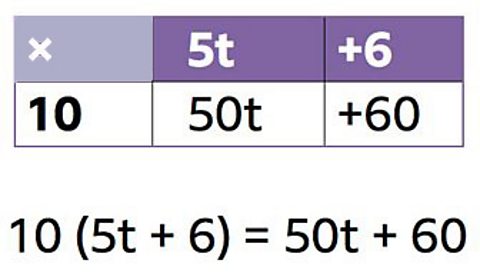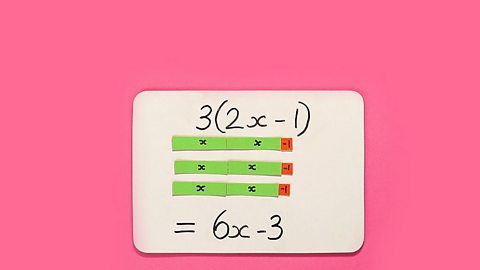Brackets in algebra are used to show when a calculation has been repeated.
The number outside the brackets shows how many times the calculation has been repeated.
To remove the brackets we multiply what is inside the brackets, by what is outside the brackets.
Learn how to multiply out brackets
Have a go

Image caption, Click here to see the slideshow.
1 of 6
How to use brackets in algebra
Brackets are used in algebra to show a repeated calculation, without having to write the same calculation out several times.
For example 3(x+1) means that there are 3 groups of x+1.
You could write it as x+1 + x+1 + x+1 but it's much easier and simpler to write it as 3(x+1).
Expanding brackets
To remove the brackets in an algebraic expression (a maths sentence that has algebra in it), you multiply what is inside the brackets by what is outside them.
This is sometimes called expanding the brackets.
Example 1
With 3(x+1) you multiply what is outside the brackets, 3, by what is inside the brackets, x+1.
This gives you 3 Ă— x + 3 Ă— 1
Which equals 3x + 3
Example 2
With 4(3y + 2) there are 4 sets of 3y + 2
To expand the brackets you multiply what is outside the brackets, in this case 4, by what is inside the brackets, 3y + 2.
This gives you 4 Ă— 3y + 4 Ă— 2
Which equals 12y + 8

Grid method
You can use a grid method to expand brackets. In this example you can expand 10(5t + 6) using a grid.
Along the top row, put each term that was inside the brackets in its own column. Include + or - with any numbers, such as +6.
Down the left-hand side, put the number outside the brackets. In this case it's 10.
Then fill in the spaces by multiplying each term separately.
With this example, you can work out that:
10(5t + 6) = 50t + 60

Brackets and algebra quiz
Test your knowledge with this quick quiz.
More on Algebra
Find out more by working through a topic
- count6 of 29

- count7 of 29

- count8 of 29

- count9 of 29
